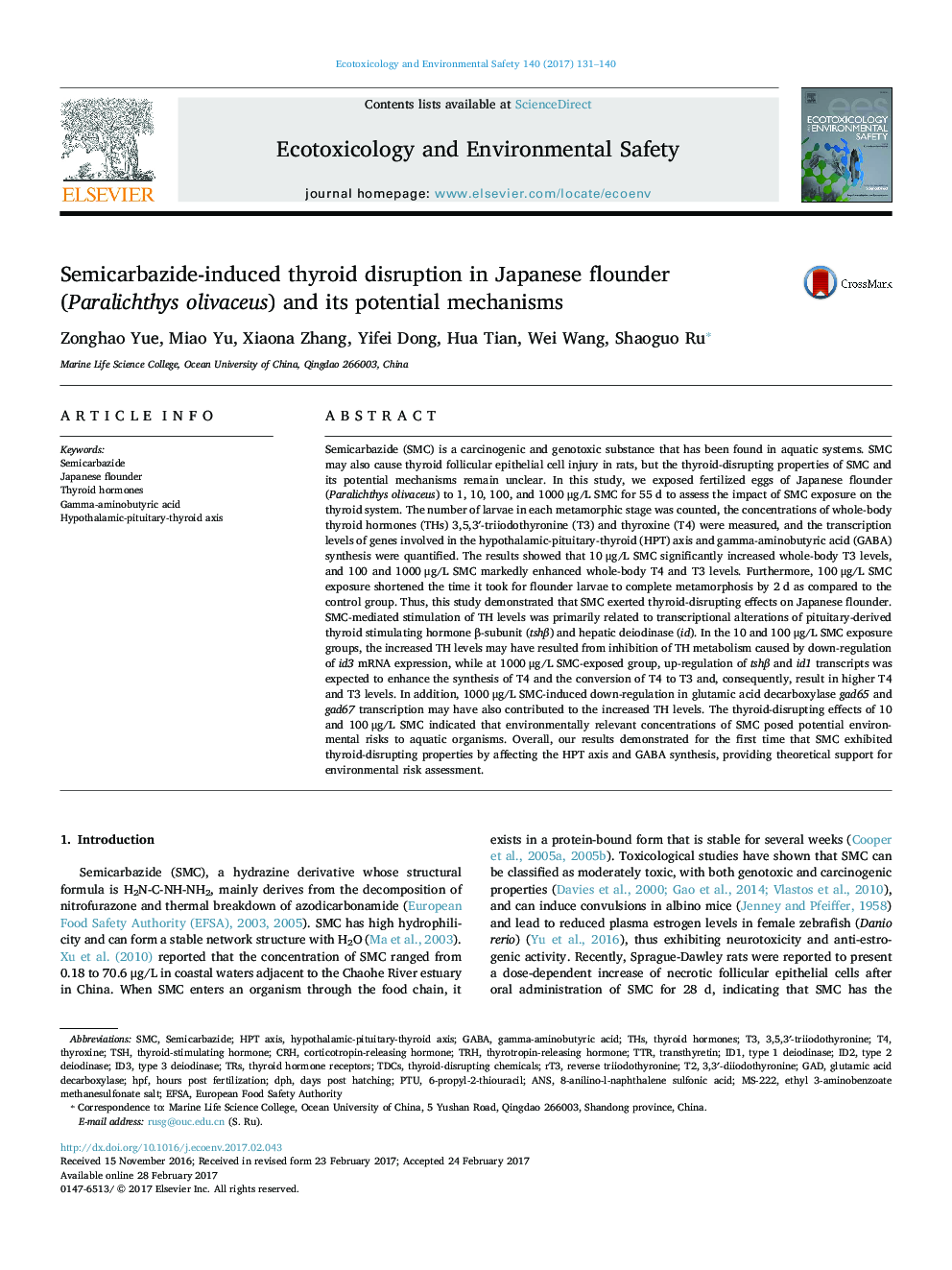| کد مقاله | کد نشریه | سال انتشار | مقاله انگلیسی | نسخه تمام متن |
|---|---|---|---|---|
| 5747674 | 1618924 | 2017 | 10 صفحه PDF | دانلود رایگان |

- SMC stimulates larval metamorphosis in Japanese flounder.
- SMC increases T4 and T3 concentrations in Japanese flounder.
- Related genes along HPT axis and GABA synthesis affect SMC-mediated TH increase.
- Semicarbazide (SMC) has thyroid-disrupting properties.
Semicarbazide (SMC) is a carcinogenic and genotoxic substance that has been found in aquatic systems. SMC may also cause thyroid follicular epithelial cell injury in rats, but the thyroid-disrupting properties of SMC and its potential mechanisms remain unclear. In this study, we exposed fertilized eggs of Japanese flounder (Paralichthys olivaceus) to 1, 10, 100, and 1000 μg/L SMC for 55 d to assess the impact of SMC exposure on the thyroid system. The number of larvae in each metamorphic stage was counted, the concentrations of whole-body thyroid hormones (THs) 3,5,3â²-triiodothyronine (T3) and thyroxine (T4) were measured, and the transcription levels of genes involved in the hypothalamic-pituitary-thyroid (HPT) axis and gamma-aminobutyric acid (GABA) synthesis were quantified. The results showed that 10 μg/L SMC significantly increased whole-body T3 levels, and 100 and 1000 μg/L SMC markedly enhanced whole-body T4 and T3 levels. Furthermore, 100 μg/L SMC exposure shortened the time it took for flounder larvae to complete metamorphosis by 2 d as compared to the control group. Thus, this study demonstrated that SMC exerted thyroid-disrupting effects on Japanese flounder. SMC-mediated stimulation of TH levels was primarily related to transcriptional alterations of pituitary-derived thyroid stimulating hormone β-subunit (tshβ) and hepatic deiodinase (id). In the 10 and 100 μg/L SMC exposure groups, the increased TH levels may have resulted from inhibition of TH metabolism caused by down-regulation of id3 mRNA expression, while at 1000 μg/L SMC-exposed group, up-regulation of tshβ and id1 transcripts was expected to enhance the synthesis of T4 and the conversion of T4 to T3 and, consequently, result in higher T4 and T3 levels. In addition, 1000 μg/L SMC-induced down-regulation in glutamic acid decarboxylase gad65 and gad67 transcription may have also contributed to the increased TH levels. The thyroid-disrupting effects of 10 and 100 μg/L SMC indicated that environmentally relevant concentrations of SMC posed potential environmental risks to aquatic organisms. Overall, our results demonstrated for the first time that SMC exhibited thyroid-disrupting properties by affecting the HPT axis and GABA synthesis, providing theoretical support for environmental risk assessment.
Journal: Ecotoxicology and Environmental Safety - Volume 140, June 2017, Pages 131-140